Course
This tutorial explains how to use the Random Forest algorithm for classification in Python. You’ll learn:
- How Random Forests work as an ensemble learning method
- How to build and train a classifier using scikit-learn
- How to evaluate your model’s performance with common metrics
To get the most from this article, you should have a basic knowledge of Python, pandas, and scikit-learn. It is helpful to understand how decision trees are used for classification, so consider reading our Decision Tree Classification in Python Tutorial first. If you are just getting started with using scikit-learn, check out Kaggle Tutorial: Your First Machine Learning Model.
While random forests can be used for both classification and regression, this article will focus on building a classification model. To easily experiment with the code in this tutorial, visit the accompanying DataLab workbook. Lastly, try taking our Model Validation in Python course, which lets you practice random forest classification using the tic_tac_toe dataset.
What Are Random Forests?
Random forests are a popular supervised machine learning algorithm that can handle both regression and classification tasks. Below are some of the main characteristics of random forests:
- Random forests are for supervised machine learning, where there is a labeled target variable.
- Random forests can be used for solving regression (numeric target variable) and classification (categorical target variable) problems.
- Random forests are an ensemble method, meaning they combine predictions from other models.
- Each of the smaller models in the random forest ensemble is a decision tree.
Become a ML Scientist
How Random Forest Classification Works
Imagine you have a complex problem to solve, and you gather a group of experts from different fields to provide their input. Each expert provides their opinion based on their expertise and experience. Then, the experts would vote to arrive at a final decision.
In a random forest classification, multiple decision trees are created using different random subsets of the data and features. Each decision tree is like an expert, providing its opinion on how to classify the data. Predictions are made by calculating the prediction for each decision tree and then taking the most popular result. (For regression, predictions use an averaging technique instead.)
In the diagram below, we have a random forest with n decision trees, and we’ve shown the first 5, along with their predictions (either “Dog” or “Cat”). Each tree is exposed to a different number of features and a different sample of the original dataset, and as such, every tree can be different. Each tree makes a prediction.
Looking at the first 5 trees, we can see that 4/5 predicted the sample was a Cat. The green circles indicate a hypothetical path the tree took to reach its decision. The random forest would count the number of predictions from decision trees for Cat and for Dog, and choose the most popular prediction.
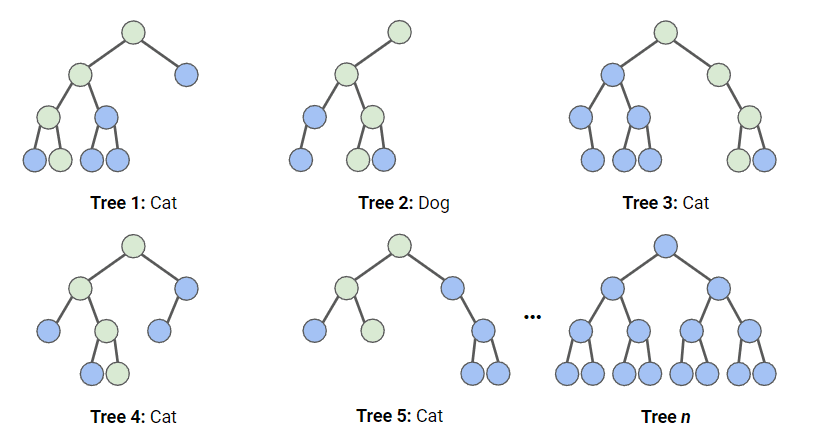 Illustration of how random forest classification works. Image by Author
Illustration of how random forest classification works. Image by Author
Load the Dataset
This dataset consists of direct marketing campaigns by a Portuguese banking institution using phone calls. The campaigns aimed to sell subscriptions to a bank term deposit. We are going to store this dataset in a variable called bank_data. The columns we will use are:
age: The age of the person who received the phone calldefault: Whether the person has credit in defaultcons.price.idx: Consumer price index score at the time of the callcons.conf.idx:Consumer confidence index score at the time of the cally: Whether the person subscribed (this is what we’re trying to predict)
Importing Packages
The following packages and functions are used in this tutorial:
# Data Processing
import pandas as pd
import numpy as np
# Modelling
from sklearn.ensemble import RandomForestClassifier
from sklearn.metrics import accuracy_score, confusion_matrix, precision_score, recall_score, ConfusionMatrixDisplay
from sklearn.model_selection import RandomizedSearchCV, train_test_split
from scipy.stats import randint
# Tree Visualisation
from sklearn.tree import export_graphviz
from IPython.display import Image
import graphvizThe Random Forest Workflow
To fit and train this model, we’ll be following The Machine Learning Workflow infographic; however, as our data is pretty clean, we won’t be carrying out every step. We will do the following:
- Feature engineering
- Split the data
- Train the model
- Hyperparameter tuning
- Assess model performance
Preprocessing Data for our Random Forest Classifier
Tree-based models are much more robust to outliers than linear models, and they do not need variables to be normalized to work. As such, we need to do very little preprocessing on our data.
- We will map our
defaultcolumn, which containsnoandyes, to0s and1s, respectively. We will treatunknownvalues asnofor this example. - We will also map our target,
y, to1s and0s.
bank_data['default'] = bank_data['default'].map({'no':0,'yes':1,'unknown':0})
bank_data['y'] = bank_data['y'].map({'no':0,'yes':1})Splitting the Data
When training any supervised learning model, it is important to split the data into training and test data. The training data is used to fit the model. The algorithm uses the training data to learn the relationship between the features and the target. The test data is used to evaluate the performance of the model.
The code below splits the data into separate variables for the features and target, then splits into training and test data.
# Split the data into features (X) and target (y)
X = bank_data.drop('y', axis=1)
y = bank_data['y']
# Split the data into training and test sets
X_train, X_test, y_train, y_test = train_test_split(X, y, test_size=0.2, random_state=42, stratify=y)Fitting and Evaluating the Random Forest Model
We first create an instance of the Random forest model with the default parameters. We then fit this to our training data. We pass both the features and the target variable so the model can learn.
rf = RandomForestClassifier()
rf.fit(X_train, y_train)At this point, we have a trained random forest model, but we need to find out whether it makes accurate predictions.
y_pred = rf.predict(X_test)The simplest way to evaluate this model is using accuracy; we check the predictions against the actual values in the test set and count up how many the model got right.
accuracy = accuracy_score(y_test, y_pred)
print("Accuracy:", accuracy)Output:
Accuracy: 0.888This is a pretty good score! However, we may be able to do better by optimizing our hyperparameters.
Note: Accuracy alone can be misleading on imbalanced data. Always check precision and recall to understand false-positive and false-negative trade-offs.
Visualizing the Results
We can use the following code to visualize our first 3 trees.
# Export the first three decision trees from the forest
for i in range(3):
tree = rf.estimators_[i]
dot_data = export_graphviz(tree,
feature_names=X_train.columns,
filled=True,
max_depth=2,
impurity=False,
proportion=True)
graph = graphviz.Source(dot_data)
display(graph)
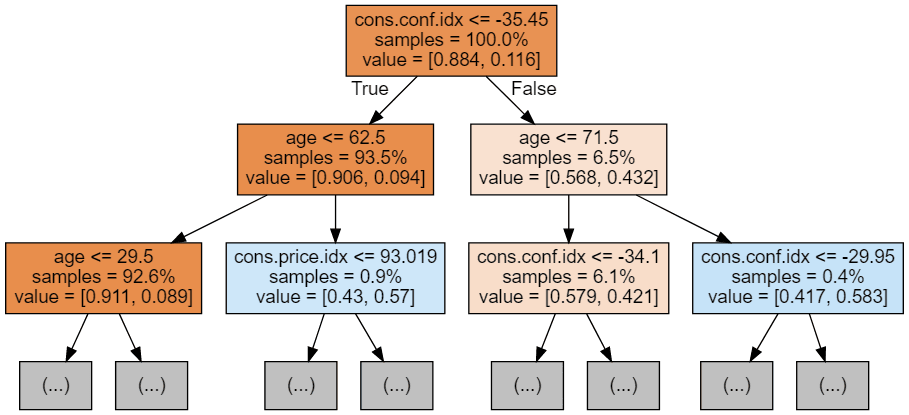
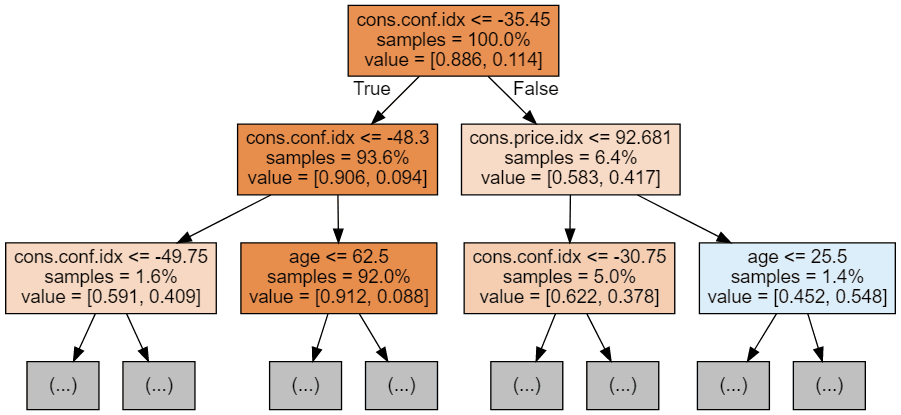
Each tree image is limited to only showing the first few nodes. These trees can get very large and difficult to visualize. The colors represent the majority class of each node (box, with red indicating majority 0 (no subscription) and blue indicating majority 1 (subscription). The colors get darker the closer the node gets to being fully 0 or 1. Each node also contains the following information:
- The variable name and value used for splitting
- The % of total samples in each split
- The % split between classes in each split
Hyperparameter Tuning
The code below uses Scikit-Learn’s RandomizedSearchCV, which will randomly search parameters within a range per hyperparameter. We define the hyperparameters to use and their ranges in the param_dist dictionary. In our case, we are using:
- n_estimators: the number of decision trees in the forest. Increasing this hyperparameter generally improves the performance of the model but also increases the computational cost of training and predicting.
- max_depth: the maximum depth of each decision tree in the forest. Setting a higher value for max_depth can lead to overfitting while setting it too low can lead to underfitting.
param_dist = {
'n_estimators': randint(100, 500),
'max_depth': randint(3, 15),
'min_samples_split': randint(2, 10),
'min_samples_leaf': randint(1, 5)
}
# Create a random forest classifier
rf = RandomForestClassifier(random_state=42, n_jobs=-1)
# Use random search to find the best hyperparameters
rand_search = RandomizedSearchCV(
rf, param_distributions=param_dist,
n_iter=10, cv=5, scoring='accuracy',
n_jobs=-1, random_state=42
RandomizedSearchCV will train many models (defined by n_iter_ and save each one as variables, the code below creates a variable for the best model and prints the hyperparameters. In this case, we haven’t passed a scoring system to the function, so it defaults to accuracy. This function also uses cross validation, which means it splits the data into five equal-sized groups and uses 4 to train and 1 to test the result. It will loop through each group and give an accuracy score, which is averaged to find the best model.
# Create a variable for the best model
best_rf = rand_search.best_estimator_
# Print the best hyperparameters
print('Best hyperparameters:', rand_search.best_params_)Output:
Best hyperparameters: {'max_depth': 5, 'n_estimators': 260}More Random Forest Evaluation Metrics
Let’s look at the confusion matrix. This plots what the model predicted against what the correct prediction was. We can use this to understand the tradeoff between false positives (top right) and false negatives (bottom left). We can plot the confusion matrix using this code:
# Generate predictions with the best model
y_pred = best_rf.predict(X_test)
# Create the confusion matrix
cm = confusion_matrix(y_test, y_pred)
ConfusionMatrixDisplay(confusion_matrix=cm).plot();Output:

Random forest classifier evaluation using a confusion matrix. Image by Author
We should also evaluate the best model with accuracy, precision, and recall (note your results may differ due to randomization)
y_pred = knn.predict(X_test)
accuracy = accuracy_score(y_test, y_pred)
precision = precision_score(y_test, y_pred)
recall = recall_score(y_test, y_pred)
print("Accuracy:", accuracy)
print("Precision:", precision)
print("Recall:", recall)Output:
Accuracy: 0.885
Precision: 0.578
Recall: 0.0873The below code plots the importance of each feature, using the model’s internal score to find the best way to split the data within each decision tree.
# Create a series containing feature importances from the model and feature names from the training data
importances = pd.Series(best_rf.feature_importances_, index=X_train.columns)
importances.sort_values(ascending=False).plot.bar()
This tells us that the consumer confidence index, at the time of the call, was the biggest predictor of whether the person subscribed.
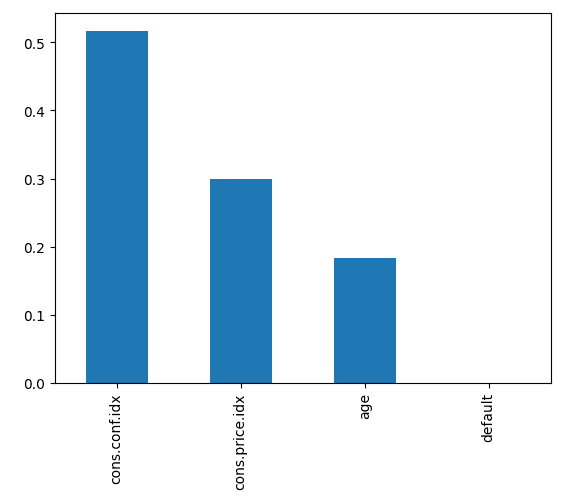
Random forest classifier features in order of importance. Image by Author
When to Use Random Forests (and When Not To)
Random Forests are a great choice when you need a strong baseline model that works well out of the box. They handle both numerical and categorical features, manage missing values gracefully, and are less prone to overfitting than single decision trees.
Use Random Forests when:
- You have tabular data with mixed feature types
- You want a robust model without heavy feature scaling or preprocessing
- Interpretability (via feature importance) matters for your application
However, Random Forests may not be ideal when:
- You need real-time predictions; they can be slower than single models
- You’re dealing with very high-dimensional data (e.g., text or images)
- You want state-of-the-art accuracy on structured data, where gradient boosting methods like XGBoost or LightGBM often outperform them
Take it to the Next Level
To get started with supervised machine learning in Python, take Supervised Learning with scikit-learn. To learn more about using random forests and other tree-based machine learning models, look at our Machine Learning with Tree-Based Models in Python and Ensemble Methods in Python courses.
Random Forest FAQs
What is random forest classification?
Random forest classification is an ensemble machine learning algorithm that uses multiple decision trees to classify data. By aggregating the predictions from various decision trees, it reduces overfitting and improves accuracy.
How does random forest prevent overfitting?
Random Forest reduces overfitting by creating multiple decision trees using different subsets of the data and features. It then averages the predictions, which makes the model more generalizable and less likely to fit noise in the training data.
What are the key hyperparameters to tune in random forest classification?
The key hyperparameters for random forest include the number of trees, the maximum depth of each tree, the minimum number of samples required to split a node, and the number of features to consider for each split.
What are the advantages of using random forest classification?
Random forest classification is robust to overfitting, performs well with large datasets, can handle both numerical and categorical features, and is less sensitive to hyperparameter tuning compared to other algorithms like neural networks.
How does random forest handle missing data?
Random forest can handle missing values by estimating them through surrogate splits or by averaging results across different decision trees, making it more tolerant to incomplete datasets compared to individual decision tree models.
What is the difference between random forest classification and random forest regression?
Random forest classification predicts categorical outcomes, such as labels or classes (e.g., "spam" or "not spam"), whereas random forest regression predicts continuous numerical outcomes, like house prices or temperatures.
